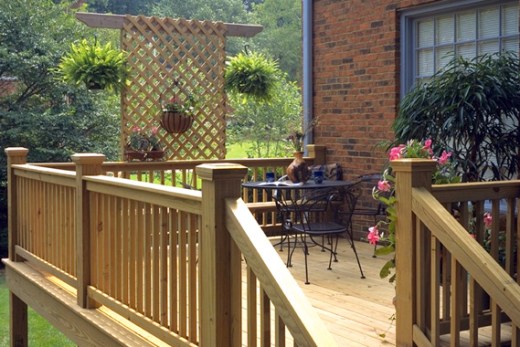What Lengths Does Azek Decking Come in
Evaluate Your House For Deck Construction

Here's how to plan a new deck that suits your property, meets your budget, and offers the best return on your investment.
In the summertime when the living is easy, there's nothing quite like a deck for cooking out, entertaining, or simply relaxing. In addition to boosting outdoor living space, a deck can be an asset when you sell your home.
More good news: Decks add living space at a fraction of the cost of fully enclosed living area. You'll pay $25 to $35 per square foot for a pro-built deck compared to $100 to $250 per square foot for an enclosed addition.
If you're a determined DIYer, plan on spending three to four weekends building a 14-foot-by-18-foot deck yourself. If you choose this route, consider buying a ready-made deck plan. Or, put to use one of the many websites with interactive design aids, such as Lowe's Deck Designer (registration required), and Deckorators.
Planning a successful deck requires careful consideration of your site, your budget, and the features you should -- or shouldn't -- include. Here are some planning priorities to bear in mind.
Deciding on the Site and Size
Your deck will be a popular place, so give careful thought to where it should be located. Begin by working out how to access it from the house. The ever-handy back door to the kitchen probably won't do the job; it will force traffic toward the cooking area, making a shambles of any large-group entertaining. A better solution is a French door or slider that gives primary access from a living room, dining room, or family room while being handy to the kitchen. If the doorway can also be positioned to offer an expansive view, all the better.
Next, make sure the deck neither swamps your yard, nor becomes lost in it. Your local codes may set standards for how much of your lot can be occupied by a deck, and how close a deck can be to your lot line. Check these limitations early in your planning with your city or county building department.
Decide where to locate stairways off the deck so they provide unobtrusive access to the backyard. Also consider the path of the sun and the location of shade trees; sunlight may be pleasant in the morning but unbearable later in the day -- having a shade tree to the west of your deck will help block the harsh late-day sun. Work out how to preserve your privacy and how to screen your deck from prevailing winds.
Related: Smart Upgrades for Decks
Think Local
To recoup a good portion of your investment, your deck needs to be right for your market. Appraiser Dick Koestner of Davenport, Iowa, recommends the simply checking out other decks in your area. "Don't make it too extreme [compared with] what's typical in your market," he counsels. "Definitely don't make it less than what is expected in the market."
Koestner also emphasizes the importance of obeying local codes. "A lot of potential purchasers are having a home inspection done," he says. "If the home inspector finds the deck isn't built to code, most of the purchasers are saying, 'Hey, fix it.'"
He emphasizes that codes exist not just to preserve property values, but promote safety. For example, railing balusters spaced too far apart can constitute a falling hazard for small children (most codes stipulate 4-inch maximum gap). In addition, a deck inadequately attached to the house can collapse, often during a party when the structure is loaded with the extra weight of many people, creating mayhem like something out of the Poseidon Adventure. So get a permit from your building department and follow their requirements.
Of course, by dint of taking out a building permit your tax assessment will rise, but only to the extent that the value of your property is increased. The effect should be minimal: Decks are considered an outdoor improvement much like a new driveway or upgraded landscaping, not additional living space.
Related: Care and Maintenance of Your Deck
Looking Good
Although it's hard to put a dollar value on aesthetics, looks count. Give thought to how the deck will meld with the architecture of your house. Railings offer a good opportunity to pull in color and detail that complements your home. Consider how the deck fits in with your backyard; it should make a smooth transition from the house to the landscape.
What Lengths Does Azek Decking Come in
Source: https://www.houselogic.com/by-room/yard-patio/evaluate-your-house-deck/